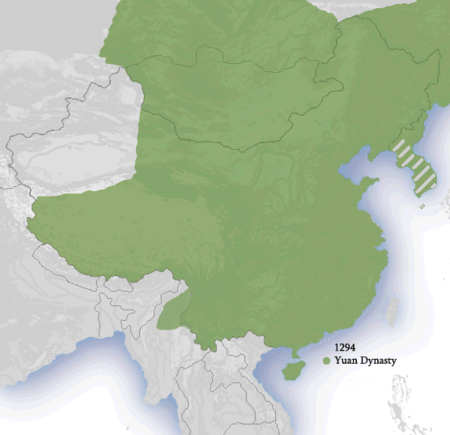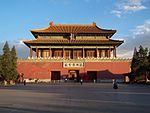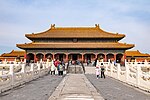Yuan dynasty

The Yuan dynasty (Chinese: 元朝; pinyin: Yuáncháo), officially the Great Yuan (Chinese: 大元; pinyin: Dà Yuán; Mongolian: ᠶᠡᠬᠡᠶᠤᠸᠠᠨᠤᠯᠤᠰ, Yeke Yuwan Ulus, literally "Great Yuan State"), was a Mongol-led imperial dynasty of China and a successor state to the Mongol Empire after its division. It was established by Kublai (Emperor Shizu), the fifth khagan-emperor of the Mongol Empire from the Borjigin clan, and lasted from 1271 to 1368. In Chinese historiography, the Yuan dynasty followed the Song dynasty and preceded the Ming dynasty. Although Genghis Khan had been enthroned with the Han-style title of Emperor in 1206 and the Mongol Empire had ruled territories including modern-day northern China for decades, it was not until 1271 that Kublai Khan officially proclaimed the dynasty in the traditional Han style, and the conquest was not complete until 1279 when the Southern Song dynasty was defeated in the Battle of Yamen. His realm was, by this point, isolated from the other Mongol-led khanates and controlled most of modern-day China and its surrounding areas, including modern-day Mongolia. It was the first dynasty founded by a non-Han ethnicity that ruled all of China proper. In 1368, following the defeat of the Yuan forces by the Ming dynasty, the Genghisid rulers retreated to the Mongolian Plateau and continued to rule until 1635 when they surrendered to the Later Jin dynasty (which later evolved into the Qing dynasty). The rump state is known in historiography as the Northern Yuan dynasty.Some of the Yuan emperors mastered the Chinese language, while others only used their native Mongolian language and the 'Phags-pa script.After the division of the Mongol Empire, the Yuan dynasty was the khanate ruled by the successors of Möngke. In official Chinese histories, the Yuan dynasty bore the Mandate of Heaven. The dynasty was established by Kublai Khan, yet he placed his grandfather Genghis Khan on the imperial records as the official founder of the dynasty and accorded him the temple name Taizu. In the edict titled Proclamation of the Dynastic Name issued in 1271, Kublai announced the name of the new dynasty as Great Yuan and claimed the succession of former Chinese dynasties from the Three Sovereigns and Five Emperors to the Tang dynasty.In addition to Emperor of China, Kublai also claimed the title of Great Khan, supreme over the other successor khanates: the Chagatai, the Golden Horde, and the Ilkhanate. As such, the Yuan was also sometimes referred to as the Empire of the Great Khan. However, while the claim of supremacy by the Yuan emperors was at times recognized by the western khans, their subservience was nominal and each continued its own separate development.
Excerpt from the Wikipedia article Yuan dynasty (License: CC BY-SA 3.0, Authors, Images).Yuan dynasty
西华门大街, Dongcheng District Donghuamen (首都功能核心区)
Geographical coordinates (GPS) Address Nearby Places Show on map
Geographical coordinates (GPS)
| Latitude | Longitude |
|---|---|
| N 39.915 ° | E 116.39 ° |
Address
故宫 (紫禁城;北京故宫;北京故宫博物院)
西华门大街
100032 Dongcheng District, Donghuamen (首都功能核心区)
Beijing, China
Open on Google Maps










